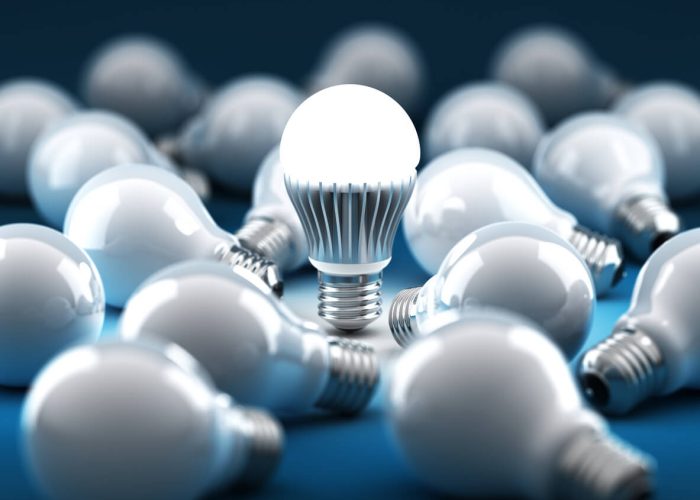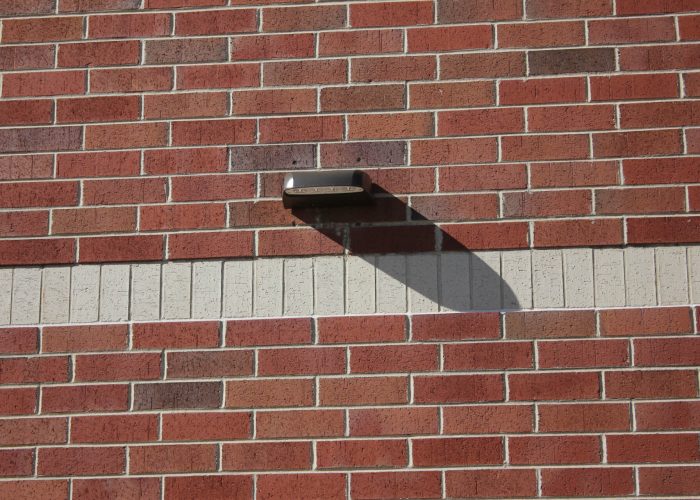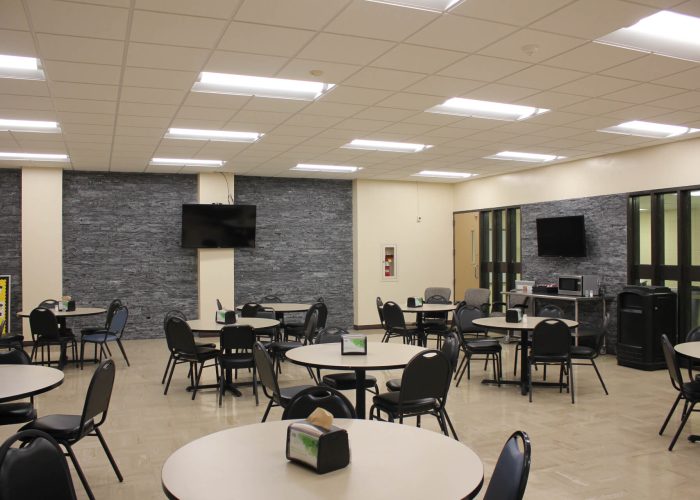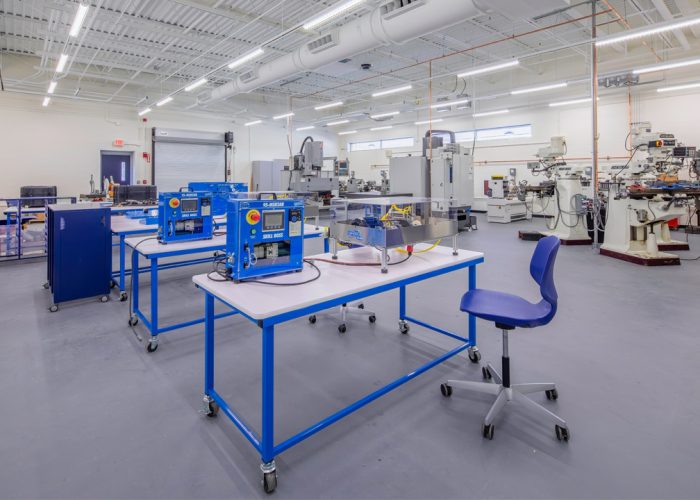Introduction
From its inception to its widespread adoption, LED lighting has revolutionized how we illuminate our surroundings, offering unparalleled energy efficiency, enhanced functionality, and improved aesthetics. Continue reading to learn the benefits LED lighting offers public owners and discover how it is reshaping the landscape of educational and municipal facilities.
The Evolution of LED Lighting
From Natural Light to LED Lighting
The history of artificial illumination dates to early civilizations that utilized fire and natural light sources. Over time, innovations like candles, oil lamps, and gas lighting emerged. However, it was not until the electrification era that lighting technology transformed with the widespread adoption of incandescent bulbs. These bulbs, pioneered by Thomas Edison and others, brought light into homes, streets, and workplaces on an unprecedented scale. Despite widespread use, they were notoriously inefficient, converting much of their energy into heat rather than light.
In the mid-20th century, fluorescent lighting emerged as a significant advancement in lighting technology. Offering greater energy efficiency and longevity compared to incandescent bulbs, fluorescent lights became the lighting choice for businesses, schools, and other commercial settings. However, despite these advantages, fluorescent lighting was not without its drawbacks, such as slow start-up times and eventual burnout.
The true lighting revolution came with the advent of Light Emitting Diodes (LEDs). Initially used primarily as indicator lights, LEDs quickly demonstrated their potential as a mainstream solution. LEDs quickly surpassed both incandescent and fluorescent bulbs in terms of energy efficiency, longevity, and sustainability. Unlike incandescent bulbs, which rely on heating a filament to produce light, LEDs generate light through the movement of electrons in a semiconductor material, resulting in significantly lower energy consumption and heat generation. These unique features make them the ideal lighting solution for public buildings.
Technological Advancements in LED Lighting
In recent years, the field of LED lighting has witnessed significant technological advancements. Some notable advancements include:
- Increased Efficiency: Efficiency gains have been made to enhance their luminous efficacy and reduce energy consumption through advancements in semiconductor materials, device design, and manufacturing processes.
- Greater Flexibility: Smaller, more compact lighting fixtures enable greater lighting design and application flexibility. Flexible LED strips and panels have become popular for architectural lighting, signage, and decorative purposes.
- Improved Color Rendering: Technological advancements offer better color rendering capabilities in LEDs, resulting in more accurate and vibrant colors. High-CRI (Color Rendering Index) LEDs are now available, offering superior color reliability compared to traditional lighting sources.
- Smart Lighting Integration: LED lighting has become an integral part of the Internet of Things (IoT) ecosystem, integrating smart lighting systems, such as smart streetlights. These systems enable remote control, scheduling, and automation of lighting settings. Additionally, sensors and IoT connectivity allow for adaptive lighting that adjusts based on occupancy, daylight levels, and user preferences, while optimizing energy efficiency and comfort.
- First Step in a Renewable Energy Strategy. Before implementing renewables, like wind or solar, it’s best to first lower your energy baseline. Public owners can do this through performance contracts. Common energy conservation measures include LED lighting retrofits, as well as a variety of other HVAC, controls, and building envelope solutions. Once completed, the renewable energy systems can be right sized to offset current energy use.
Frequently Asked Question: How is light quality measured?
The Benefits of LED Lighting for schools, municipalities, and higher education institutions
Learning and Productivity Benefits
LED lighting is the smart choice for schools, municipalities, and higher education institutions looking to improve the indoor environment for students, faculty, and staff. Benefits include:
- Enhanced Visibility: LED lighting offers consistent and uniform illumination, reducing glare and shadows. This creates an optimal visual environment for reading, writing, and other tasks, minimizing eye strain and fatigue.
- Better Color Rendering: LEDs accurately render colors compared to natural sunlight. This is particularly beneficial in educational/classroom settings where accurate color perception is essential for art, science experiments, and presentations.
- Improved Focus and Concentration: Proper lighting levels, color temperature, and uniformity provided by LED lighting can positively impact the ability to focus and concentrate. Studies have shown that well-lit environments contribute to increased attention spans and better retention of information.
- Circadian Rhythm Regulation: LED lighting with tunable white capabilities can mimic the natural changes in daylight throughout the day. Adjusting the color temperature of the light supports circadian rhythms, helping with alertness during the day and better sleep patterns at night.
- Reduced Distractions: LED lighting with dimming capabilities can create a calm and focused atmosphere by reducing harsh lighting levels during certain activities or times. This helps minimize distractions and promotes a conducive learning or working environment.
- Increased Productivity: Properly lit environments have positively impacted productivity and performance. By providing optimal lighting conditions, LED lighting can help building occupants stay engaged and productive throughout the day, leading to better academic outcomes in the case of schools.
Enhanced Energy Efficiency
The enhanced energy efficiency of LED makes it a sustainable and cost-effective lighting solution for various applications, from classrooms, labs, and athletic spaces to outdoor and industrial environments. As technology advances, further improvements in LED efficiency are expected, driving even greater energy savings and environmental benefits in the years to come. But for now, key reasons LED bulbs are more efficient include:
- Low Energy Consumption: LED lights consume significantly less energy to produce the same amount of light as traditional bulbs. They achieve this through converting electrical energy into light with minimal wasted energy in the form of heat. As a result, LED lighting requires less electricity to operate, meaning lower energy bills and reduced environmental impact.
- High Luminous Efficacy: LEDs have a high luminous efficacy, producing more light output per unit of electrical power input. This efficiency is achieved through advancements in semiconductor materials and device design, allowing LEDs to convert more electrical energy into visible light.
- Directional Lighting: Unlike traditional bulbs that emit light in all directions, LEDs emit light in a specific direction, often through a lens or reflector. This directional lighting minimizes wasted light and allows for more precise illumination of targeted areas, further improving energy efficiency.
- Long Lifespan: LEDs have a much longer lifespan than traditional bulbs, lasting tens of thousands of hours before needing replacement. This longevity reduces the frequency of bulb replacements, which saves on maintenance costs.
- Instant On/Off: LED lights have instant on/off capabilities, meaning they reach full brightness immediately upon being switched on and do not require warm-up time like fluorescent bulbs. This feature eliminates the need for energy-intensive preheating cycles, further enhancing energy efficiency.
- Dimming Capabilities: Many LED lighting fixtures are dimmable, allowing users to adjust the brightness levels to match specific lighting needs. Dimming LEDs reduces energy consumption proportionally to the reduced light output, providing additional energy savings without sacrificing lighting quality or comfort.
Health and Environmental Benefits
The health and environmental benefits of LED lighting make it a sustainable and responsible choice for various applications. LED lighting plays a crucial role in creating a brighter and more sustainable future for all by promoting energy efficiency, reducing environmental impact, and supporting human health and well-being. Here’s how:
- Reduced Environmental Impact: The longer lifespan of LED lights reduces the frequency of replacements.
- Energy Efficiency: They require less electricity to produce the same amount of light. The result is lower energy bills and reduced greenhouse gas emissions associated with energy production. Switching to LED lighting can contribute to energy conservation and combat climate change.
- Reduced Light Pollution: LED light systems can be designed to emit light only where needed, reducing light pollution, and minimizing the negative impacts on wildlife, ecosystems, and human health.
- Improved Visual Comfort: LED lights offer flicker-free illumination with no noticeable hum or buzz, providing occupants with a more comfortable visual environment. This can reduce eye strain, headaches, and other discomfort associated with flickering or low-quality lighting, improving comfort and productivity.
Economic Advantages
The economic advantages of LED lights make it a wise investment for schools, cities/towns, and colleges/universities looking to lower operating expenses and enhance overall efficiency.
- Energy Savings: LED lights are highly energy-efficient, consuming significantly less electricity than traditional lighting sources. This equals lower energy bills and substantial long-term savings on utility costs.
- Reduced Maintenance Costs: LED lights’ long lifespan saves on replacement costs and reduces the need for ongoing maintenance. LED fixtures require less frequent servicing and repairs than traditional lighting systems, lowering maintenance expenses over time.
- Government Incentives and Rebates: Many governments and utility companies offer financial incentives and rebates for upgrading to energy-efficient LED lighting. These incentives can help offset initial investment costs and accelerate the adoption of LED lighting.
- Cost-effective Upgrades: The cost of LED technology, coupled with improvements in performance and efficiency, makes LED lighting an increasingly cost-effective option for various applications. Further, when implemented as part of an energy savings performance contract, the upgrade can pay for itself over time with the energy savings.
Frequently Asked Question: What are the benefits of LED Lighting?
Practical Applications of LED Light Systems and Case Studies
LED Retrofitting in Existing Structures
Just because your existing fixtures don’t accommodate LED bulbs doesn’t mean that they can’t be retrofitted to do so. Retrofitting a building to LED lighting can vary in complexity depending on size and layout of the building, the existing lighting infrastructure, and the scope of the retrofit project. While it may require careful planning and coordination, retrofitting to LED lighting is generally considered feasible and worthwhile for many buildings, given the increased efficiency.
LED retrofit solutions are designed to be compatible with existing lighting fixtures and infrastructure, making it relatively straightforward to upgrade without the need for major modifications. While there are a variety of LED retrofit kits on the market, it is best to partner with a qualified provider or electrician for installation. Better yet, work with a Nationally Accredited Energy Services Company, like Performance Services, to design solutions guaranteed to pay for themselves through energy and operational savings. Through energy savings performance contracts, public owners can trust that their projects are designed for maximum efficiency and will deliver those results.
Related Reading: Unlocking Savings and Efficiency: A Public Owner’s Guide to Performance Contracting
Case Examples: LED Retrofits as an Energy Conservation Measure
School districts, cities/towns, and higher education institutions across the U.S. are switching to LED lighting in classrooms, gymnasiums, auditoriums, parks, sports fields, and parking lots. A few recent examples of working with public owners to make the switch to LED include:
- Michigan City Area Schools was recognized with a 2018 Governor’s Award for their LED and Solar project. The district installed 2.83MW of solar, which, when paired with the district’s LED retrofit, offsets approximately 52 percent of combined electricity usage at seven buildings, with expected net energy savings of $23 million over 30 years.
- Ysleta Independent School District in Texas sought an LED retrofit at seven school buildings because they had illumination levels significantly below IESNA recommended levels. The project improved illumination levels to provide a more optimal learning environment. The project also included dimmable sports field lighting and wireless lighting controls.
- The City of Dayton, Texas, partnered with Performance Services on a phase II energy savings project that, in addition to wastewater treatment plant improvements, included LED lighting upgrades. LED lighting was installed at all seven baseball fields at Daniel Park and in four city buildings.
- Arkansas Tech University implemented a campus-wide energy savings program through the Arkansas Energy Performance Contracting (AEPC) Program. Most of the project includes campus-wide LED lighting upgrades for interior and exterior lighting.
- The City of Rushville, Indiana, renovated a century-old historic building into a thriving city center. The project included major renovations to complete the project, but energy conservation and sustainability were top of mind. As a result, all new LED lighting fixtures were installed throughout the building to provide optimal lighting levels for the mixed-use building.
Related Reading: Outdoor Lighting: The Unexpected Benefits of Utilizing LEDs
LED Implementation in New Construction Projects
With a renewed focus on ENERGY STAR® and LEED buildings, LED lighting has become the preferred choice due to its flexibility for indoor and outdoor use, energy efficiency, long lifespan, and environmental sustainability. But its the ability to seamlessly integrate into modern design makes it the top choice for designers when creating innovative spaces. LEDs come in many sizes, shapes, and applications, so architects and engineers can find the right solutions to enhance the visual appeal and user experience while providing superior functionality. For example, LED design solutions include pendant lights, recessed lighting, ceiling tiles, backlit wall panels, recessed floor lighting, and landscape fixtures.
Specialty Applications – Smart Technology
LED lighting’s ability to integrate with the Internet of Things for smart lighting applications and controls further drives adoption. Smart LED lighting systems allow for automated lighting control, occupancy sensing, daylight harvesting, scheduling, and remote monitoring and management via mobile devices or building management systems to become smart cities.
Related Reading: Developing Smart Cities: A Guide for City Leaders
The Future of LED Lighting
Looking toward the future, LED lighting promises continued innovation to meet changing needs of users and the environment. Advancements include greater efficiency, integration with smart technology, and human health and well-being support. Efficiency improvements will lead to even more energy savings, while smart lighting systems offer enhanced control and connectivity. Human-centric lighting, mimicking natural daylight, may become more prevalent, promoting better productivity and health. Sustainability will remain a key focus, with innovations in energy harvesting and environmentally friendly manufacturing processes driving progress.
Conclusion
The widespread adoption of LED lighting is revolutionizing public buildings, offering a multitude of benefits for schools, municipalities, and higher education institutions alike. It has transformed the way we illuminate our surroundings. In schools, it enhances learning environments and supports student well-being. Municipalities benefit from energy efficiency and cost savings, while higher education institutions leverage their versatility and sustainability. As we continue seeing advancements in LED technology and its integration into public buildings, the future holds great promise for brighter, more efficient, and more sustainable environments for all.
Interested in learning how much you could save on energy costs by switching to LED lighting systems? Reach out to us today, and our team of experts can help determine which LED measures can have the biggest impact on your bottom line and indoor learning or working environment.





